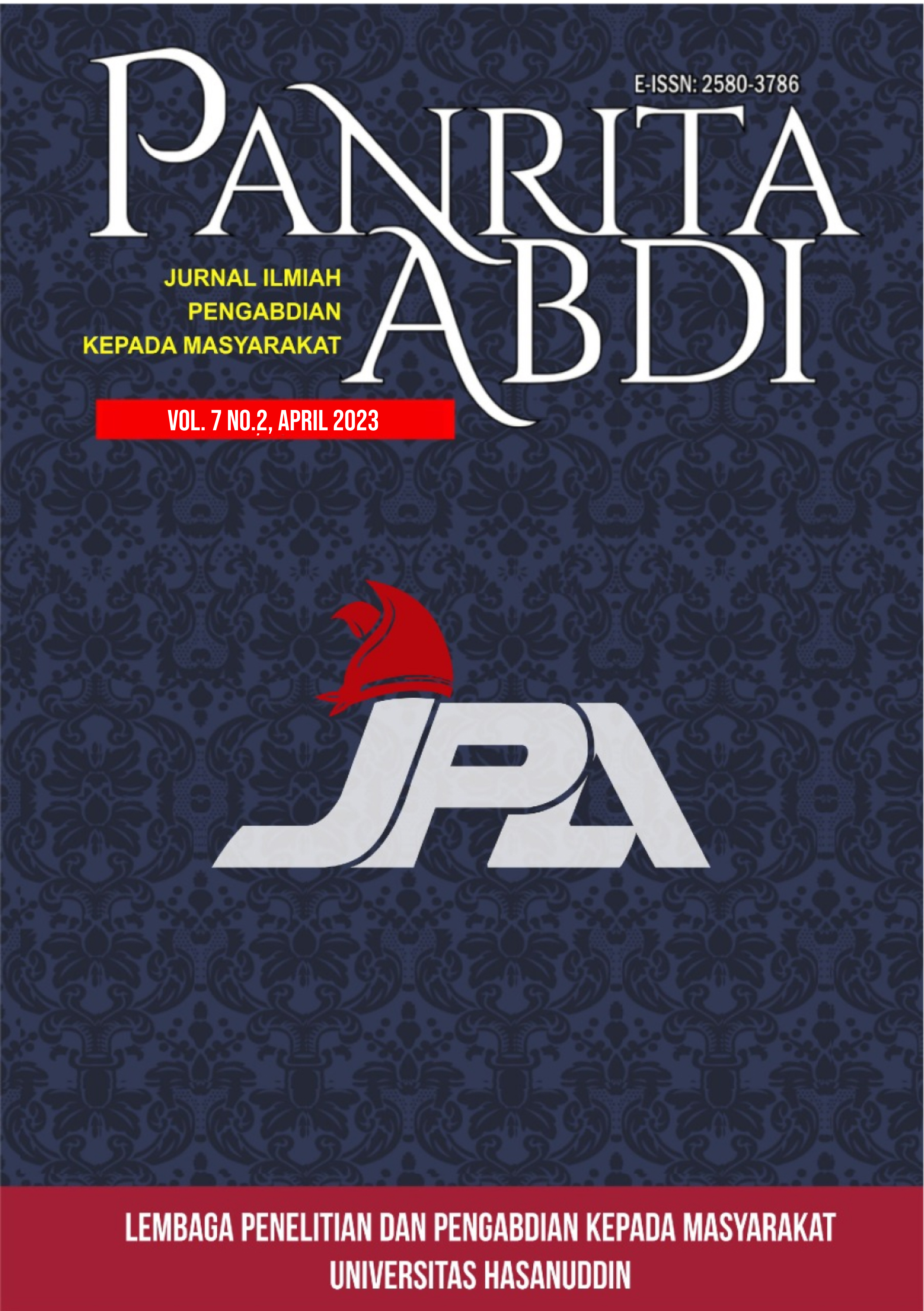PENERAPAN MODEL AGROFORESTRI PADA KELOMPOK TANI HUTAN FETOMONE DI DESA SILLU KECAMATAN FATULEU KABUPATEN KUPANG
DOI:
https://doi.org/10.20956/pa.v7i2.18070Keywords:
Agroforestry, critical land, alley croppingAbstract
The Government of Eastern Nusa Tenggara province is currently facing the problem of an increasing size of critical land as well as decreasing availability of clean water which occurs in most of the landscape of Timor island. The increasing size of critical lands resulted from biophysical conditions, socio-economic and cultural situations which related to land use as the main factor for production, as well as the policy implementation that did not consider sustainability. One of the largest critical land can be found in Sillu village which is located in Fatuleu District in Kupang Regency. To overcome this critical land problem, an appropriate Agroforestry model is set to be developed and implemented. This community service aims to overcome the critical area in Sillu village and to increase the community’s well being through the implementation of an Agroforestry model specifically for the Fetomone Forest-Farmer group. Following methods were used: (1) site survey and family approach towards local community through head of the village, head of hamlets, and chair of Fetomone Forest-Farmer group; (2) Focus Group Discussion were conducted with head of the village and chair of Fetomone Forest-Farmer group to developed an activity plan including modelling design that will be used; (3) Community sensitization regarding socio, ecology and economic benefit of agroforestry system through lecture and discussion; and (4) Training in making agroforestry’s plot. Focus Group Discussion resulting in modelling design of Agrosilvopastural with alley cropping pattern. 53 local communities participated in community sensitization resulting in 96.2% understanding the socio, ecology and economic benefit of agroforestry system. 37 participants from Forest-Farmer group were included in the agroforestry’s plot making trainiing. Our 3 months post planting monitoring showed that 86.48% of them have been implemented the design on their own agricultural land. --- Permasalahan yang dihadapi pemerintah NTT adalah peningkatan luas lahan kritis dan ketersedian air bersih yang terjadi pada sebagian besar daerah yang berada pada bentangan Pulau Timor. Peningkatan luas lahan kritis merupakan kesatuan yang bersifat simultan antara kondisi biofisik, sosial ekonomi dan budaya yang berkaitan dengan pemanfaatan lahan sebagai faktor produksi utama, serta penerapan kebijakan yang kurang mempertimbangkan kelestarian. Salah satu daerah yang memiliki lahan kritis yang cukup luas adalah Desa Sillu yang berada di Kecamatan Fatuleu Kabupaten Kupang. Untuk mengatasi masalah tersebut, tim pengabdian menerapkan model agroforestri. Tujuan pengabdian adalah untuk mengatasi lahan kritis di Desa Sillu dan meningkatkan kesejahteraan masyarakat melalui penerapan model agroforestri di Kelompok Tani Hutan Fetomone. Metode yang digunakan adalah 1) survei lokasi dan metode pendekatan kekeluargaan dengan masyarakat lokal melalui Kepala Desa, Kepala Dusun, dan Ketua Kelompok Tani Fetomone, 2) Metode Focus Group Discusion (FGD) dengan Kepala Desa dan Ketua Kelompok Tani Fetomeno untuk menyusun perencanaan kegiatan termasuk rancangan desain model yang akan digunakan, 3) Penyuluhan kepada masyarakat tentang manfaat sosial, ekologis, dan produktif (ekonomi) dari sistem agroforestri dengan metode ceramah dan diskusi, 4) Pelatihan pembuatan demplot agroforestri. FGD menghasilkan desain model agosilvopastural dengan pola tanam alley cropping. Penyuluhan melibatkan 53 masyarakat dan hasilnya 96,2% memahami manfaat sosial, ekologis, dan produktif (ekonomi) dari sistem agroforestri. Pelatihan pembuatan demplot melibatkan 37 anggota KTH dan hasil monitoring setelah 3 bulan kegiatan menunjukkan bahwa 86,48% sudah menerapkan model tersebut di lahan milik pribadi.Downloads
References
Ariani, R. & Haryati, U. (2018). Sistem alley cropping : Analisis SWOT dan Strategi Iplementasinya di Lahan Kering DAS Hulu. Jurnal Sumber Daya Lahan, Volume 12 (1), 13-31. ISSN 1907-0799.
Bidura, I.G.N.G. (2017). Buku Ajar Agroforestry Kelestarian Lingkungan. Fakultas Peternakan Niversitas Udayana. Denpasar.
Faqih, A., Jadmiko, S.D., & Geru, A.S. (2015). Keragaman dan Perubahan Iklim di Nusa Tenggara Timur. Direktorat Jenderal Pengendalian dan Perubahan Iklim. Kementerian Lingkungan Hidup dan Kehutanan.
Fitriah, L., Fitrianingsih, Y., & Jumiati, J. (2020). Penerapan Teknologi Penanaman Mangrove di Kabupaten Mempawah Provinsi Kalimantan Barat. Jurnal Panrita Abdi Volume 4 (2) : 126 – 135.
Islami, T. & Utomo, W.H. (2006). Limpasan Permukaan Dan Erosi Tanah Setelah Sepuluh Tahun Menggunakan Sitem Pertanaman Lorong. Buana Sains Volume 6 (1) 51-58.
Juanda, J.S., Assa'ad, D.N. & Warsana. (2003). Kajian Laju Infiltrasi dan Beberapa Sifat Fisik Tanah pada Tiga Jenis Tanaman Pagar Dalam Sistem Budidaya Lorong. Jurnal Tanah dan Lingkungan Volume 4 (1) : 25-31.
Kadir, A.W., Awang, S.A., Purwanto, R.H. & Poedjiraharjoe, E. (2012). Analisis Sosial Ekonomi Masyarakat sekitar Taman Nasional Bantimurung Bulusaraung, Provinsi Sulawesi Selatan. J Manusia dan Lingkungan Volume 19(1):1–11.
Makkarennu, Syahidah, Ridwan, Sahide, M.A.K., & Mas’ud, E.I.R. (2018). Pengembangan Pasar dan Penguatan Kapasitas Kewirausahaan Kelompok Tani Hutan di Sekitar Kawasan Hutan Pendidikan Unhas. Jurnal Panrita Abdi, Volume 2 (1):64-74.
Suhartati & Wahyudi, A. (2011). Pola agroforestry tanaman penghasil gaharu dan kelapa sawit. Jurnal Penelitian dan Konservasi Alam. Volume 8 (4): 363-371.
Wang Li, Tang, L., Wang, X., & Chen, F. (2010). Effects Of Alley Crop Planting On Soil And Nutrient Losses In The Citrus Orchards Of The Three Georges Region. Soil And Tillage Research 110 (2010) : 243-250. Elsevier.
Wijayanto, N., & Araujo, J.D. (2011). Pertumbuhan Tanaman Pokok Cendana (Santalum Album Linn.) Pada Sistem Agroforestry Di desa Sanirin, kecamatan Balibo, kabupaten Bobonaro, Timor Leste. Jurnal Silvikultur Tropika. Volume 3 (01):119–123.
Wolz, K.J. & De Lucia, E.H. (2018). A Review. alley cropping system : global patterns of species composition and function. Agriculture, Ecosystem and Environtment 252 (2018) : 61 – 68. Elsevier.
Downloads
Published
How to Cite
Issue
Section
License
Copyright (c) 2023 Meilyn Reny Pathibang, Fransiskus Dako, Aryani, Wisnu Wardhana, Jeriels Matatula, Fabianus Ranta, Adrin, Ina Kleruk, Ika Kristinawanti, Ramses Elim

This work is licensed under a Creative Commons Attribution-NonCommercial-NoDerivatives 4.0 International License.



















